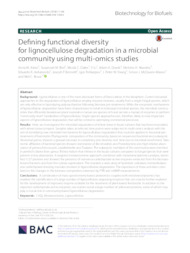Defining functional diversity for lignocellulose degradation in a microbial community using multi-omics studies.
Defining functional diversity for lignocellulose degradation in a microbial community using multi-omics studies.
Autoria: ALESSI, A. M.; BIRD, S. M.; OATES, N. C.; LI, Y.; DOWLE, A. A.; NOVOTNY, E. H.; AZEVEDO, E. R. de; BENNETT, J. P.; POLIKARPOV, I.; YOUNG, J. P. W.; MCQUEEN-MASON, S. J.; BRUCE, N. C.
Resumo: Background: Lignocellulose is one of the most abundant forms of fixed carbon in the biosphere. Current industrial approaches to the degradation of lignocellulose employ enzyme mixtures, usually from a single fungal species, which are only effective in hydrolyzing polysaccharides following biomass pre-treatments. While the enzymatic mechanisms of lignocellulose degradation have been characterized in detail in individual microbial species, the microbial communities that efficiently breakdown plant materials in nature are species rich and secrete a myriad of enzymes to perform "community-level" metabolism of lignocellulose. Single-species approaches are, therefore, likely to miss important aspects of lignocellulose degradation that will be central to optimizing commercial processes. Results: Here, we investigated the microbial degradation of wheat straw in liquid cultures that had been inoculated with wheat straw compost. Samples taken at selected time points were subjected to multi-omics analysis with the aim of identifying new microbial mechanisms for lignocellulose degradation that could be applied in industrial pretreatment of feedstocks. Phylogenetic composition of the community, based on sequenced bacterial and eukaryotic ribosomal genes, showed a gradual decrease in complexity and diversity over time due to microbial enrichment. Taxonomic affiliation of bacterial species showed dominance of Bacteroidetes and Proteobacteria and high relative abundance of genera Asticcacaulis, Leadbetterella and Truepera. The eukaryotic members of the community were enriched in peritrich ciliates from genus Telotrochidium that thrived in the liquid cultures compared to fungal species that were present in low abundance. A targeted metasecretome approach combined with metatranscriptomics analysis, identified 1127 proteins and showed the presence of numerous carbohydrate-active enzymes extracted from the biomassbound fractions and from the culture supernatant. This revealed a wide array of hydrolytic cellulases, hemicellulases and carbohydrate-binding modules involved in lignocellulose degradation. The expression of these activities correlated to the changes in the biomass composition observed by FTIR and ssNMR measurements. Conclusions: A combination of mass spectrometry-based proteomics coupled with metatranscriptomics has enabled the identification of a large number of lignocellulose degrading enzymes that can now be further explored for the development of improved enzyme cocktails for the treatment of plant-based feedstocks. In addition to the expected carbohydrate-active enzymes, our studies reveal a large number of unknown proteins, some of which may play a crucial role in community-based lignocellulose degradation.
Ano de publicação: 2018
Tipo de publicação: Artigo de periódico
Unidade: Embrapa Solos
Palavras-chave: CAZy, Lignocellulose, Metasecretome
Observações
1 - Por padrão são exibidas publicações dos últimos 20 anos. Para encontrar publicações mais antigas, configure o filtro ano de publicação, colocando o ano a partir do qual você deseja encontrar publicações. O filtro está na coluna da esquerda na busca acima.
2 - Para ler algumas publicações da Embrapa (apenas as que estão em formato ePub), é necessário ter, no celular ou computador, um desses softwares gratuitos. Sistemas Android: Google Play Livros; IOS: iBooks; Windows e Linux: software Calibre.
Acesse outras publicações
Acesse a Base de Dados da Pesquisa Agropecuária (BDPA) para consultar o acervo completo das bibliotecas da Embrapa.

